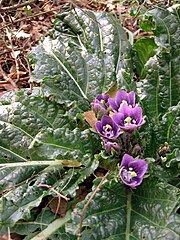Mandrake
| Mandragora subsp. var. | Mandrake | |||||||||||||||||||||||||||||||||||||||||||||||||||||||
|---|---|---|---|---|---|---|---|---|---|---|---|---|---|---|---|---|---|---|---|---|---|---|---|---|---|---|---|---|---|---|---|---|---|---|---|---|---|---|---|---|---|---|---|---|---|---|---|---|---|---|---|---|---|---|---|---|

|
|
| ||||||||||||||||||||||||||||||||||||||||||||||||||||||
| ||||||||||||||||||||||||||||||||||||||||||||||||||||||||
Mandrake is the common name for members of the plant genus Mandragora belonging to the nightshades family (Solanaceae). Because mandrake contains deliriant hallucinogenic tropane alkaloids and the roots sometimes contain bifurcations causing them to resemble human figures, their roots have long been used in magic rituals.
The mandrake, Mandragora officinarum, is a plant called by the Arabs luffâh, or beid el-jinn ("djinn's eggs"). The parsley-shaped root is often branched. This root gives off at the surface of the ground a rosette of ovate-oblong to ovate, wrinkled, crisp, sinuate-dentate to entire leaves, 5 to 40 cm long, somewhat resembling those of the tobacco-plant. A number of one-flowered nodding peduncles spring from the neck bearing whitish-green flowers, nearly 5 cm in broad, which produce globular, succulent, orange to red berries, resembling small tomatoes, which ripen in late spring. All parts of the mandrake plant are poisonous. The plant grows natively in southern and central Europe and in lands around the Mediterranean Sea, as well as on Corsica.
| Standard Cyclopedia of Horticulture |
|---|
|
Mandragora (name used by Hippocrates, said to signify that the plant is hurtful to cattle). Solanaceae. Mandrake. Old medicinal herbs. A genus of three or four species, one of which is supposed to be the dudaim mentioned in Genesis, chapter 30. In America the name mandrake is applied to the mayapple, Podophyllum peltatum, but the mandrake of history is a plant with a large spindle-shaped root which was supposed sometimes to become forked and resemble the I human form. In this condition it was used as an aphrodisiac. The plant was also called love-apple, and many superstitions about it still survive. The old herbals abound in fanciful pictures of the mandrake, one of which is reproduced in Fig. 2317. M. officinarum may be cultivated in the hardy border for its folk-lore interest. M. autumnalis is supposed by some to be the true mandrake. Both are natives of the Mediterranean region. M. caulescens is found in the Himalayas. The mandrakes are allied to belladonna (Atropa) and have poisonous qualities. Mandragoras are mostly stemless perennial herbs with thick roots and large, stalked, wavy-margined lvs., the later ones being usually narrower and entire, and rather large fls. varying from whitish through bluish violet and purplish shades: fls. purple, bell-shaped, about 5-cut, netted-veined and borne in clusters among the tufted lvs.; calyx deeply 5-cut; sinus of the corolla induplicate between the lobes; stamens 5:fr. a globose or oblong juicy berry.
|
Cultivation
Propagation
Pests and diseases
Species
Mandragora autumnalis
Mandragora officinarum
Mandragora turcomanica
Mandragora caulescens
Gallery
References
- Standard Cyclopedia of Horticulture, by L. H. Bailey, MacMillan Co., 1963
External links
- w:Mandrake. Some of the material on this page may be from Wikipedia, under the Creative Commons license.
- Mandrake QR Code (Size 50, 100, 200, 500)

